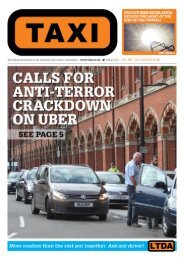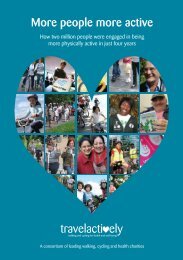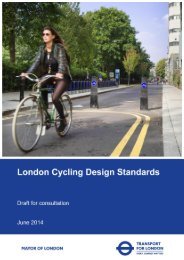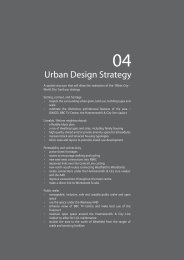- Page 1:
Travel in London Travel in London R
- Page 5 and 6:
Overview ..........................
- Page 7 and 8:
8.1 Introduction and content ......
- Page 9 and 10:
5 Travel in London, Report 8
- Page 11 and 12:
Overview Overview Travel in London
- Page 13 and 14:
Overview of 67.1 per cent in journe
- Page 15 and 16:
Overview upgrade programme, includi
- Page 17 and 18:
Overview the impact of temporary di
- Page 19 and 20:
Overview ‘fair’; perception of
- Page 21 and 22:
Overview • The overall distance t
- Page 23 and 24:
Overview • Within the overall con
- Page 25 and 26:
1. Introduction and contents 1. Int
- Page 27 and 28:
1. Introduction and contents 1.3 Mo
- Page 29 and 30:
Travel demand and performance of th
- Page 31 and 32:
2. Overall travel trends in London
- Page 33 and 34:
2. Overall travel trends in London
- Page 35 and 36:
2. Overall travel trends in London
- Page 37 and 38:
2. Overall travel trends in London
- Page 39 and 40:
2. Overall travel trends in London
- Page 41 and 42:
2. Overall travel trends in London
- Page 43 and 44:
2. Overall travel trends in London
- Page 45 and 46:
2. Overall travel trends in London
- Page 47 and 48:
2. Overall travel trends in London
- Page 49 and 50:
2. Overall travel trends in London
- Page 51 and 52:
2. Overall travel trends in London
- Page 53 and 54:
3. Travel trends by mode 3. Travel
- Page 55 and 56:
3. Travel trends by mode • Passen
- Page 57 and 58:
3. Travel trends by mode 10.6 per c
- Page 59 and 60:
3. Travel trends by mode Figure 3.5
- Page 61 and 62:
3. Travel trends by mode Table 3.1
- Page 63 and 64:
3. Travel trends by mode Table 3.2
- Page 65 and 66:
3. Travel trends by mode Figure 3.9
- Page 67 and 68:
3. Travel trends by mode Figure 3.1
- Page 69 and 70:
3. Travel trends by mode Figure 3.1
- Page 71 and 72:
3. Travel trends by mode Light good
- Page 73 and 74:
3. Travel trends by mode and partly
- Page 75 and 76:
3. Travel trends by mode Although U
- Page 77 and 78:
4. Performance of the transport net
- Page 79 and 80:
4. Performance of the transport net
- Page 81 and 82:
4. Performance of the transport net
- Page 83 and 84:
4. Performance of the transport net
- Page 85 and 86:
4. Performance of the transport net
- Page 87 and 88:
4. Performance of the transport net
- Page 89 and 90:
4. Performance of the transport net
- Page 91 and 92:
4. Performance of the transport net
- Page 93 and 94:
4. Performance of the transport net
- Page 95 and 96:
4. Performance of the transport net
- Page 97 and 98:
4. Performance of the transport net
- Page 99 and 100:
Progress towards MTS transport goal
- Page 101 and 102:
5. Operational efficiency, public t
- Page 103 and 104:
5. Operational efficiency, public t
- Page 105 and 106:
5. Operational efficiency, public t
- Page 107 and 108:
5. Operational efficiency, public t
- Page 109 and 110:
6. Safety and security on the trans
- Page 111 and 112:
6. Safety and security on the trans
- Page 113 and 114:
6. Safety and security on the trans
- Page 115 and 116:
6. Safety and security on the trans
- Page 117 and 118:
6. Safety and security on the trans
- Page 119 and 120:
6. Safety and security on the trans
- Page 121 and 122:
6. Safety and security on the trans
- Page 123 and 124:
6. Safety and security on the trans
- Page 125 and 126:
7. The Customer Experience 7. The c
- Page 127 and 128:
7. The Customer Experience • That
- Page 129 and 130:
7. The Customer Experience Figure 7
- Page 131 and 132:
7. The Customer Experience • Pers
- Page 133 and 134:
7. The Customer Experience Figure 7
- Page 135 and 136:
7. The Customer Experience Figure 7
- Page 137 and 138:
7. The Customer Experience markings
- Page 139 and 140:
7. The Customer Experience proporti
- Page 141 and 142:
7. The Customer Experience of the w
- Page 143 and 144:
8. Transport connectivity, physical
- Page 145 and 146:
8. Transport connectivity, physical
- Page 147 and 148:
8. Transport connectivity, physical
- Page 149 and 150:
8. Transport connectivity, physical
- Page 151 and 152:
8. Transport connectivity, physical
- Page 153 and 154:
8. Transport connectivity, physical
- Page 155 and 156:
8. Transport connectivity, physical
- Page 157 and 158:
8. Transport connectivity, physical
- Page 159 and 160: 8. Transport connectivity, physical
- Page 161 and 162: 8. Transport connectivity, physical
- Page 163 and 164: 8. Transport connectivity, physical
- Page 165 and 166: 8. Transport connectivity, physical
- Page 167 and 168: 9. London’s air quality and green
- Page 169 and 170: 9. London’s air quality and green
- Page 171 and 172: 9. London’s air quality and green
- Page 173 and 174: 9. London’s air quality and green
- Page 175 and 176: 9. London’s air quality and green
- Page 177 and 178: 9. London’s air quality and green
- Page 179 and 180: 9. London’s air quality and green
- Page 181 and 182: 9. London’s air quality and green
- Page 183 and 184: 9. London’s air quality and green
- Page 185 and 186: 9. London’s air quality and green
- Page 187 and 188: 9. London’s air quality and green
- Page 189 and 190: 10. The London 2012 Games and their
- Page 191 and 192: 10. The London 2012 Games and their
- Page 193 and 194: 10. The London 2012 Games and their
- Page 195 and 196: 10. The London 2012 Games and their
- Page 197 and 198: 10. The London 2012 Games and their
- Page 199 and 200: 10. The London 2012 Games and their
- Page 201 and 202: 10. The London 2012 Games and their
- Page 203 and 204: 10. The London 2012 Games and their
- Page 205 and 206: 10. The London 2012 Games and their
- Page 207 and 208: Spotlight topics 203 Travel in Lond
- Page 209: 11. Spotlight: How has travel by Lo
- Page 213 and 214: 11. Spotlight: How has travel by Lo
- Page 215 and 216: 11. Spotlight: How has travel by Lo
- Page 217 and 218: 11. Spotlight: How has travel by Lo
- Page 219 and 220: 11. Spotlight: How has travel by Lo
- Page 221 and 222: 11. Spotlight: How has travel by Lo
- Page 223 and 224: 11. Spotlight: How has travel by Lo
- Page 225 and 226: 11. Spotlight: How has travel by Lo
- Page 227 and 228: 11. Spotlight: How has travel by Lo
- Page 229 and 230: 11. Spotlight: How has travel by Lo
- Page 231 and 232: 11. Spotlight: How has travel by Lo
- Page 233 and 234: 11. Spotlight: How has travel by Lo
- Page 235 and 236: 11. Spotlight: How has travel by Lo
- Page 237 and 238: 11. Spotlight: How has travel by Lo
- Page 239 and 240: 11. Spotlight: How has travel by Lo
- Page 241 and 242: 11. Spotlight: How has travel by Lo
- Page 243 and 244: 11. Spotlight: How has travel by Lo
- Page 245 and 246: 11. Spotlight: How has travel by Lo
- Page 247 and 248: 11. Spotlight: How has travel by Lo
- Page 249 and 250: 11. Spotlight: How has travel by Lo
- Page 251 and 252: 11. Spotlight: How has travel by Lo
- Page 253 and 254: 11. Spotlight: How has travel by Lo
- Page 255 and 256: 11. Spotlight: How has travel by Lo
- Page 257 and 258: 11. Spotlight: How has travel by Lo
- Page 259 and 260: 12. Spotlight: The transport challe
- Page 261 and 262:
12. Spotlight: The transport challe
- Page 263 and 264:
12. Spotlight: The transport challe
- Page 265 and 266:
12. Spotlight: The transport challe
- Page 267 and 268:
12. Spotlight: The transport challe
- Page 269 and 270:
12. Spotlight: The transport challe
- Page 271 and 272:
12. Spotlight: The transport challe
- Page 273 and 274:
12. Spotlight: The transport challe
- Page 275 and 276:
12. Spotlight: The transport challe
- Page 277:
12. Spotlight: The transport challe








